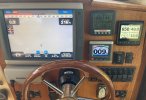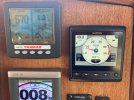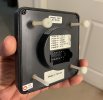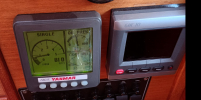CaspersCruiser
Well-known member
- Joined
- May 11, 2016
- Messages
- 873
- Fluid Motion Model
- R-27 Classic
- Hull Identification Number
- FMLT2709G112
- Vessel Name
- Cookie
- MMSI Number
- 368203460
Boats powered by the Yanmar 4BY2 engine have an engine display that is truly awful. The Yanmar i5601E LCD display is hard to read unless light conditions on it are ideal, even after adjusting the backlight. Being a moderately tall person does not help with the view angle. When lighting conditions make it hard to read the display, I use a small LED wand light at the helm to illuminate the display face.
Well, sports fans, I have put that LED light away! I installed a Garmin GMI-20 marine display and it is LIGHT YEARS better than the Yanmar display.
Jeff Howell, who lives in the Seattle area, owns a Yanmar-powered R27. A few months ago, he posted a picture and details of upgrades to the electronics at his helm. What immediately caught my eye was the bright, contrasty engine display on which I could easily read the parameters in the photo.
I messaged Jeff and he gave me the skinny on the Garmin GMI-20. He said installation wiring was a simple connection to the boat’s NMEA 2000 backbone. What’s not simple is the need to enlarge the Yanmar display’s existing 2 3/8” diameter hole in the instrument panel to 3 1/2” to accommodate the Garmin display. I will explain how I did that in another post.
The GMI-20 will display engine parameters in a digital or analog format. It not only displays engine parameters, but it will also display navigation information it gets from other devices connected to the NMEA 2000 backbone.
My only beef with the GMI-20 concerns the analog displays. In some of its analog displays, the value to which the analog indicator is pointing on the dial is also displayed precisely in small digits at the bottom of the analog display. That’s good because the analog dial graduations are not very precise and not well labeled. However, the mini digital values are not on all the analog displays, which is a real head scratcher. The space for them is there. It makes no sense. Hopefully that will be corrected in a future firmware update.
Also, the GMI-20 will not display the engine alarm codes when there is one, as the Yanmar display does. That’s certainly not a deal breaker to me. Two or three times during my seven year ownership of this boat, there has been a problem where an engine code was displayed. In each case, the code and engine manual’s explanation was so nebulous that it was zero help in correcting the issue.
Here’s where I purchased my GMI-20:
https://www.hodgesmarine.com/gar010-011 ... splay.html
The GMI-20 is $500, but to me, worth every penny. If your i5601E goes bad, I’ve seen them for sale at $1,100! That makes the GMI-20 a no-brainer.
Here are a couple photos:
This photo shows two things. 1) The size of the display 2) The analog engine instrument displays, one with a digital readout and three without. Dumb, dumb, dumb.

This photo shows the engine parameters as I have them currently configured— a mixture of digital and analog.

Well, sports fans, I have put that LED light away! I installed a Garmin GMI-20 marine display and it is LIGHT YEARS better than the Yanmar display.
Jeff Howell, who lives in the Seattle area, owns a Yanmar-powered R27. A few months ago, he posted a picture and details of upgrades to the electronics at his helm. What immediately caught my eye was the bright, contrasty engine display on which I could easily read the parameters in the photo.
I messaged Jeff and he gave me the skinny on the Garmin GMI-20. He said installation wiring was a simple connection to the boat’s NMEA 2000 backbone. What’s not simple is the need to enlarge the Yanmar display’s existing 2 3/8” diameter hole in the instrument panel to 3 1/2” to accommodate the Garmin display. I will explain how I did that in another post.
The GMI-20 will display engine parameters in a digital or analog format. It not only displays engine parameters, but it will also display navigation information it gets from other devices connected to the NMEA 2000 backbone.
My only beef with the GMI-20 concerns the analog displays. In some of its analog displays, the value to which the analog indicator is pointing on the dial is also displayed precisely in small digits at the bottom of the analog display. That’s good because the analog dial graduations are not very precise and not well labeled. However, the mini digital values are not on all the analog displays, which is a real head scratcher. The space for them is there. It makes no sense. Hopefully that will be corrected in a future firmware update.
Also, the GMI-20 will not display the engine alarm codes when there is one, as the Yanmar display does. That’s certainly not a deal breaker to me. Two or three times during my seven year ownership of this boat, there has been a problem where an engine code was displayed. In each case, the code and engine manual’s explanation was so nebulous that it was zero help in correcting the issue.
Here’s where I purchased my GMI-20:
https://www.hodgesmarine.com/gar010-011 ... splay.html
The GMI-20 is $500, but to me, worth every penny. If your i5601E goes bad, I’ve seen them for sale at $1,100! That makes the GMI-20 a no-brainer.
Here are a couple photos:
This photo shows two things. 1) The size of the display 2) The analog engine instrument displays, one with a digital readout and three without. Dumb, dumb, dumb.

This photo shows the engine parameters as I have them currently configured— a mixture of digital and analog.








